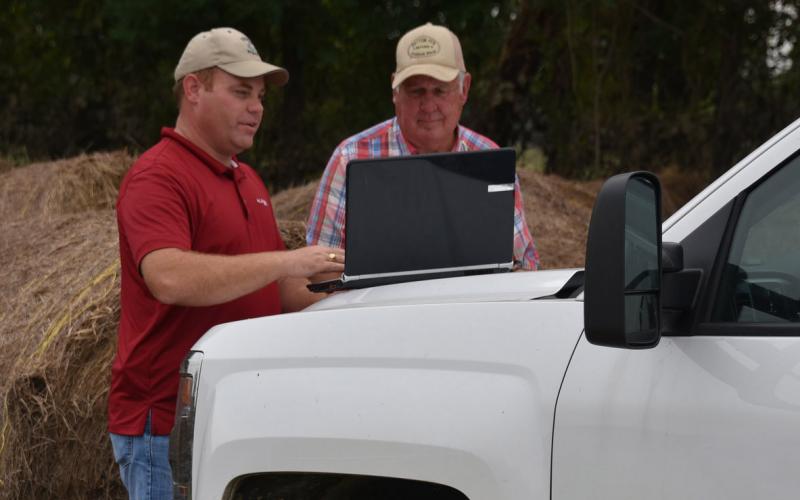Originally written by Tracey Erickson, former SDSU Extension Dairy Field Specialist.
National Farm Safety Week serves as a safety reminder for those involved in agriculture. During harvest, we will see an increase in farm equipment on the road, including tractors, combines, grain carts, silage choppers and silage trucks. Within agriculture, this is one of the busiest times of year. Additionally, the hustle and bustle has increased for the general public with youth back in school and extra-curricular activities in full swing. Thus, we all need to increase our awareness and patience whether we are a motorist or producer traversing the road.
As motorists, there are things we need to remember. First patience is key. Most farm equipment that is operating on the roadways is traveling at speeds between 15-25 mph. When encountering a Slow Moving Vehicle (SMV) Emblem on equipment it is an immediate warning to slow down. We also need to remember that it may be necessary to operate farm equipment on the roadways to move between fields or farms and they are also entitled to do so, legally. An example that is often cited is that if you are driving 55 mph and come upon farm equipment that is driving 15 mph, it will only take five seconds to close a gap the length of a football field between you and the farm equipment. Motorists should also not assume that a producer knows you are there. However, once they know you are there they will attempt to pull over, if they are able to do so safely, so you may pass. Patience is key, there may not always be an approach that is immediately accessible or a ditch that allows them to ride the shoulder without tipping or running into an object. If you choose to pass, please do so with caution using the following guidelines:
- Be aware of other vehicles behind you that may also be trying to pass.
- If you enter the oncoming lane of traffic, do not pass unless you are able to see clearly in front of you and the farm equipment you are passing.
- Do not pass if there are incoming hills or curves which may block your view.
- Do not pass if you are in a designated “No Passing Zone” or within 100 feet of any intersection, railroad crossing, or bridge.
- Do not assume if farm equipment slows down and pulls out to the right that they will be turning right or is letting you pass. Due to the size of today’s farm equipment many must execute very wide left-hand turns and in fact may be turning left instead. Check for hand signals, turn signals, or approaches.
- Remember that farm equipment is very large and cannot stop on a dime.
Agricultural producers also need to do their part as they share the roadways. All vehicles that move less than 25 mph must be equipped with a SMV (Slow Moving Vehicle) reflective emblem. The emblem should be kept clean, must be visible, and replacement is recommended every 2-3 years. Producers should also place reflective tape on equipment marking the edges of the farm equipment, helping to increase visibility. In regards to lighting and traversing roadways with farm equipment keep the following in mind:
- Tractors or other farm equipment that is operated on roadways must be equipped with lights if operated on roads at night or when there are conditions of reduced visibility.
- Use your flashing amber lights to increase motorist awareness when entering the roadway, but turn your rear spotlights off, as they are often mistaken for headlights.
- Putting flashing amber lights on older equipment that may not have lights will help signal motorist attention. Temporary magnetic lighting is available for older farm equipment. The key is keeping the battery charged and working.
- Try to avoid major roadways during high traffic periods, rush hour, bad weather or at night if possible.
- If it is necessary to travel long distances on the roadways, consider using pilot cars in front and behind of the farm equipment, especially at night. Make sure pilot cars use their flashing lights or hang a bright flag in the window.
- Installation of mirrors on equipment will help you view motorists around you.
- Lock brake pedals together for road travel, as sudden braking on one wheel can cause a tractor to skid and lose control.
- Check all towed equipment to make sure it is properly secured and balanced along with having proper lighting and reflective equipment. It should also be towed by equipment that is able to tow it adequately and stop it under control.
- Whenever feasible take steps to make equipment as “traffic friendly” as possible. Combines with wide heads are very difficult to see around and/or pass. Putting the head on a trailer creates fewer problems for other vehicles to safely pass.
- Traveling at appropriate speeds will allow you to maintain control at all times.
- Make sure all employees who may be operating farm equipment on public roadways are trained adequately and are aware of the rules of the road.
- Stay alert of all hazards on the road such as soft or steep shoulders, bridges, ruts, narrow roadways, potholes or objects on the path of travel.
- When cars are lined up behind you, and there is a suitable shoulder or approach please pull over and let the traffic pass.
Lastly, whether you are an agricultural producer or a motorist traveling on roadways, remember we must all obey the traffic rules, which includes no texting and appropriate use of cell phones. Courtesy and patience are key to safety on the road.


